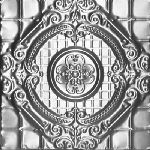

My blogger friends and I partnered with them on a variety of DIY projects for our homes.
Tin ceiling tiles full#
Read my full disclosure policy here.ĭIY Decor Store carries a huge selection of tile, ceiling, backsplash and wall panels in an array of styles, finishes and colors. This is a sponsored post, and it may contain affiliate links, for your shopping convenience. I’m really excited to be partnering with DIY Decor Store today to showcase three easy DIY projects using faux tin ceiling tiles. Luckily, you can get the vintage tin ceiling tile look, without the expense or the worries about lead paint, by using faux tin ceiling tiles. I always look for the old panels at antique stores and flea markets, but the real ones can be very expensive. I have always had a thing for pressed tin ceilings, the kind you find in old buildings.

Use the point where the lines intersect as your starting spot.Add architectural interest and vintage style to your home with one of these easy DIY decor projects using faux tin ceiling tiles. Snap two chalk lines: one that bisects the ceiling’s length and one that bisects its width.
Tin ceiling tiles pro#
TOH Pro Tip: “For a pleasing layout, and to avoid awkward cuts at the ends, always work from the center of the ceiling out.

Grid and hanger wires are not included in panel prices. This method subtracts at least 3 inches from the ceiling height, but it accommodates deep, coffered panels and can cover unsightly ducts, pipes, and soffits. A metal grid, suspended from the ceiling by wires, supports the edges of each panel no fasteners required. Available only from American Tin Ceiling’s SnapLock line available from American Tin Ceiling.ģ. Screw the panel’s flanges directly to drywall or plaster, then slide the adjacent panels’ tongues into the grooves. Dimples on the panels indicate where to drive the fasteners.Ģ. You can hammer in cone-head nails or shoot in 18-gauge brads with a pneumatic nailer. With this traditional installation method, shown at left, panels are fastened to either ⅜-inch plywood or a gridwork of 1×3 furring strips, screwed to the ceiling joists. Available from M-Boss Anatomy of a Tin Ceilingġ. 2400 Hammered filler, about $2.50 per square foot, all aluminum in mill finish. EC0400 Duchess cornice, about $2.50 per linear foot and No. Shown: 2-by-2-foot field panels in Butterfly Needlepoint pattern No.
Tin ceiling tiles install#
But now you have a wider choice of factory finishes and colors, and more DIY-friendly ways to install the panels. Incredibly, many historic patterns are still sold some 70 years after tin’s heyday came to an end. Today, most panels are made of 30-gauge tin-plated steel a mere 1/100 inch thick. The 2-by-2- and 2-by-4-foot panels were originally stamped out of steel and called “steel ceilings.” It wasn’t until later, when the raw steel panels were plated in tin to help slow down rusting, that the colloquial term tin ceilings arose. Tin was not only an aesthetic upgrade, meant to emulate high-end decorative plaster, it also offered a measure of fire protection-a big concern at a time when home cooking, lighting, and heating were largely done with open flames. Tin ceilings originated in the 1880s as an affordable way for people to dress up a room’s fifth wall. But cover it with richly patterned metal panels, and instantly it becomes an eye-catching feature. A plain white ceiling hardly rates a cursory glance.


 0 kommentar(er)
0 kommentar(er)
